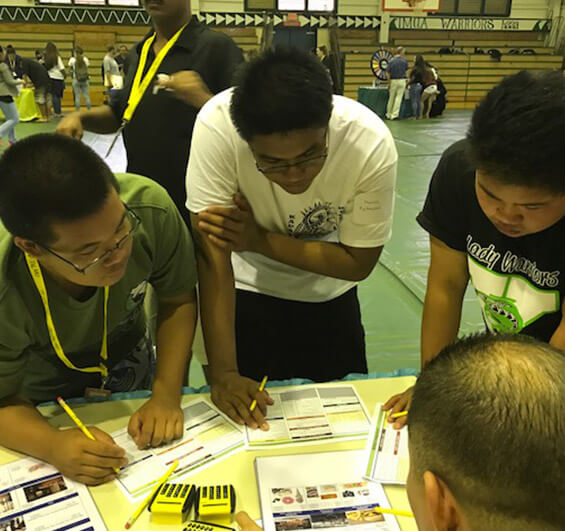
Kauai Youth Report
To monitor the progress of Kaua`i youth, K2C completes a bi-annual report on the achievement, health, and well-being of Kaua`i young people ages 0-24 years
Keiki to Career believes that the foundation of a child’s success begins in the home, with a loving and supportive family. That support must extend into the schools and community. It is upon this foundation that our young people can be most successful. The Keiki to Career Leadership Council embraces the view that the community must rally together to create supportive environments for our young people to thrive – at home, in the community and in our schools.
The 2022 Kaua’i Youth Report is a snapshot of Kaua’i’s young people from birth to workforce entry. Published biannually, it offers relevant information and guidance to the Keiki to Career initiative, the community, and policymakers looking to identify areas of common need and focus. We also use this data to measure our progress and adjust our strategies as needed.
The 2022 edition features a number of new indicators, many focused on the physical, mental and emotional health of our island youth to ensure we are assessing their social-emotional well-being. The report is [normally] published every two years and includes data on physical health (physical activity, screen time, alcohol and drug use, sexual activity), social and emotional health (positive adult relationships, abuse and neglect, bullying, depression, and suicide), academic performance (absenteeism, academic performance on tests, preschool participation, and social-emotional learning) and college and career readiness (degrees and certificates completed, college enrollment, youth not in school or working). This year, the report also includes socio-economic indicators that measure poverty, housing stability, and internet access.

In the “Good News to Celebrate” section below, we highlight some indicators where we saw positive movement, while in the “Areas Where More Support is Needed” section, we outline areas where we can do better. More information is available on each indicator in the individual sections that follow.
Good News to Celebrate
- Internet Access – In the latest available data (2019), 92% of households on Kauaʻi have access to high-speed internet. This is better than Hawaiʻi as a whole, which is higher than the nation.
- Juvenile Justice – Since 2016, fewer of our youth have been arrested, committed status offenses or felonies as rates for all three of these measures have steadily declined.
- Children with Health Insurance – Thanks in part to Hawaii’s tradition of (nearly) universal healthcare, 97% of our keiki and young people (ages 0-18) have medical insurance coverage.
- Chronic Absenteeism – This important measure has declined slightly in our island’s high schools in the most recent years.
- English Proficiency in 11th Grade – Proficiency in English Language Arts increased from 2018 to 2020 (2019 was not measured due to the pandemic).
- On-Time Graduation – This indicator continues to be a bright spot for our island’s schools, increasing steadily from 2015. Our rate is now higher than the rest of Hawaiʻi and the U.S.
Areas Where More Support is Needed
- Children in Poverty – According to this broader measure of poverty (ALICE: Asset Limited, Income Constrained, Employed) Kaua‘i’s rate of households in poverty reached 44% in 2020, despite the aid provided by The American Rescue Plan Child Tax Credit (which ended in early 2022).
- Housing: Overcrowded – In 2020, 10% of Kaua’i households were overcrowded, (defined as having more than 1 person per room). Given the recent run-up in housing and rent prices, this problem has likely increased.
- Physical Activity – The rates of physical activity remain stubbornly low, with less than 40% of high schoolers on Kaua’i getting at least 1 hour per day, 5 days a week of physical activity. Middle schoolers are a little more active.
- Feeling Sad – This indicator has risen in the most recent period (2019) for all three populations; Kaua’i, the state and the nation, and by roughly 5 points since 2017. This means 1 of 3 of our youth feel sad for 2 weeks or more during a year.
- Screen Time – The percentage of students spending more than 3 hours per day (not including television or homework-related activities), remains near 40%.
- Science Proficiency in 8th Grade – This indicator fell in the most recent period (2019) and now shows that less than 1 in 4 Kaua’i students meets or exceeds proficiency. Since many of the STEM (Science, Technology, Engineering & Mathematics) jobs are some of the highest paid, this leaves our youth at a disadvantage.
- Math Proficiency in 11th Grade – The number of students that meet or exceed proficiency on Mathematics fell for Kaua’i in 2020 from 2018 (2019 was not measured due to the pandemic) to 25%.
The Keiki to Career Leadership Council and our many community partners are working together to continually improve these indicators, so that our youth may lead healthy, fulfilling and purposeful lives.



